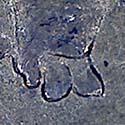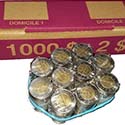First Reports

The counterfeit coins which would soon become known as "Camel Toe Toonies" were introduced to the world via Reddit and the Coin Community Forum on July 8, 2020. A coin collector in the Greater Toronto Area posted that they had been finding high quality counterfeit toonies on and off since March of that year. What pushed them to post their findings was a hoard of 75 fake toonies being found in a single cash register till. The collector went on to provide photos and a brief video of the coins that they found. Read these original posts by following the links from our Media and Links page.
Camel Toe Toonies are the second major series of counterfeit toonies since 1996, the first being the "Montreal Mint Toonies" fifteen years earlier.
Where Are They?

Since then, collectors from across the country have been on the hunt for these spurious bimetallic coins. While the fake toonies are being found easily in major cities such as Ottawa, Montreal and elsewhere, the highest concentrations are in the Greater Toronto Area with multiple reports of entire rolls or even multiple entire rolls of counterfeit coins being obtained from banks. In one case, a collector found an entire box and a half (30 rolls or $1500) in fake coins at a bank. That bank originally had two full boxes but had been handing out rolls all morning before being alerted that they were fake. According to a manager at the time, those two boxes arrived in an overnight shipment from their coin supplier. In most cases however, the counterfeits are being found one or two at a time and are circulating easily as they are mixed with genuine toonies.
Some collectors, particularly in the GTA and other hot spots, are reporting saturation levels of over 10% whereas other areas are averaging a fraction of that at only 0.5% or less.
Doing the math with the most conservative of these numbers, one could estimate that there are 5 million counterfeit coins in circulation. This assumes an overall saturation rate of 0.5% against a cumulative mintage of genuine toonies by the Royal Canadian Mint of 1 billion pieces since 1996. If accurate, these estimates should be extremely alarming!
What Is Being Done About Them?

The Royal Canadian Mint, in an article in the Belleville Intelligencer from March of 2021 says that "it is aware of an unconfirmed complaint". Responding to another media inquiry, the Mint said that finding a fake is "a very rare occurrence." They have declined further comment.
For the first two years since the initial discovery of the counterfeits, police services did not seem to be taking the matter seriously, with no official comments being made to the media. Unless a large quantity of counterfeit coins is reported to the police, the workloads and relative priorities of other cases means that no officer will spend much time investigating a single fake coin obtained in change from the local coffee shop.
Almost all banks also seem to not be concerned about this influx of imitations. With one notable exception, the banks seem to be carrying on with no special attention being paid to whether or not the coins they take in are genuine. Some banks may count a few rolls out of a box to ensure that the rolls are full, and a few might look to see that they are indeed toonies as opposed to washers, but many banks simply accept the coins as-is.
The exception comes from a collector's first-hand experience in Trenton, Ontario, in May of 2021. This collector brought several boxes of rolled toonies into a TD Canada Trust branch where the tellers proceeded to open up every single roll and not only count the coins in each roll but also examine each coin to check for counterfeits. Of course coming from this collector there were none but between the collector and two bank tellers, almost two hours of total time was spent on this endeavour.
UPDATE (2022-05-10): The Royal Canadian Mounted Police issued a press release, their first official comment on the subject of counterfeit toonies, saying that since mid-2021, approximately 10,000 counterfeit toonies had been seized. Additionally, a 68-year-old male from Richmond Hill, Ontario, had been arrested and charged with uttering counterfeit money and possession of counterfeit money. Read the full press release linked from our Media and Links page.
While the arrest is good news, the press release highlights several issues. First, the R.C.M.P. had no investigation for an entire year while these coins were flooding the Canadian economy, despite multiple reports from collectors alerting them to the fakes. Second, the arrest of one person will probably not spell the end of this scourge. With the number of counterfeits that have been seen and the estimated total to exist in circulation, it is unlikely that a single individual is responsible for it all.
It also remains to be seen as to what the Royal Canadian Mint will do about the counterfeit coins. The most effective solution would be to actively withdraw all toonies dated 1996-2012 (prior to receiving the upgraded security features in 2012) and fill the void with new toonies that are more secure and resistant to counterfeiting. Without any official comment from the Mint, it is too early to tell if this sort of operation is in effect, and it would take several years to remove the majority of old coins.
Identifying Camel Toe Toonies
- Seven years:
- 1996, 2002, 2004, 2005, 2006, 2007, 2010
- All normal polar bear designs
- Two varieties for the 2005 obverse: Non-Serif (CT05) and Serif (CT05A)
- Obvious cleft front paw: the "Camel Toe"
- Extra lines on left side of ice floe
- Font differences on dates
- Generally poor engraving quality on bear and portraits

Genuine Toonie

Camel Toe Toonie
The "Camel Toe" as described and pictured above is the most obvious and most reliable way to identify a counterfeit toonie of this variety. Additional identifying features are secondary but may be limited to certain years, may not be as easily discernable or may not be as reliable. Other methods such as dropping a coin or feeling for a weight difference are unreliable and should be discouraged.
Font Differences
There are two known obverse varieties with a 2005 date: Non-serif and Serif. While the genuine 2008 Quebec commemorative toonie uses a serif font for the obverse legend, it has a different layout. No other genuine toonie uses a serif font for the obverse legend.

2005 Non-Serif Obverse (CT05)

2005A Serif Obverse (CT05A)
The font used to produce the dates is slightly different than on genuine coins.
- 1996: Generally good match
- 2002:
- Thinner lines
- Straight tail on 9 vs. curved
- Wider digits overall, wider hyphen
- Misaligned 5
- 2004, 2005, 2006:
- Pinched zeroes
- Straight tail on 6 vs. curved
- 2007:
- More curvy/rounded digits
- Digits more tightly spaced
- Digits out of alignment
- 2010:
- More curvy/rounded digits
- Digits more tightly spaced
- Top of 1 is different
In the below images, the upper coin is genuine with a counterfeit below.







Other Identifying Features
- Maple Leaf: On 1996 and 2002 counterfeits, the maple leaf at the top of the obverse side appears crudely defined. On 2005A counterfeits, the maple leaf is noticeably larger than normal.
- No "SB" Initials: On 2004, 2005, 2006, 2007 and 2010 counterfeits, the
initials of the artist, Susanna Blunt, which normally appear as "SB" along the bottom edge
of the portrait, are missing.
- Caution! Even on genuine coins, the initials are often worn, scratched or hard to see. They are entirely not present though on counterfeits.
- Position of Maple Leaf and Legend: On 2004, 2005 and 2006 counterfeits, the maple leaf at the top of the obverse side and the text of the legend is too close to the outer rim. On a genuine coin, these elements are centered within the ring. The centering is normal along the bottom of the coin.

L: Counterfeit, R: Genuine

L: Counterfeit, R: Genuine

Maple leaf is too close to edge
Other Technical Findings

The Camel Toe toonies have been weighed and generally come in about 3-5% lighter than genuine toonies from the same date range. This is not a noticable weight difference. It should also be noted that genuine toonies from 2012 onwards with upgraded security features have a similar weight to the Camel Toe toonies.
The Camel Toe toonies are produced from two separate pieces, a core and a ring, which are made of different metals. The two pieces are assembled and then struck as a single piece. Just like a genuine toonie, the core is non-magnetic and the ring is magnetic.
Image Gallery

Common Reverse

1996 Obverse (CT96)

1952-2002 Obverse (CT02)

2004 Obverse (CT04)

2005 Obverse (CT05)

2005A Obverse (CT05A)

2006 Obverse (CT06)

2007 Obverse (CT07)

2010 Obverse (CT10)
